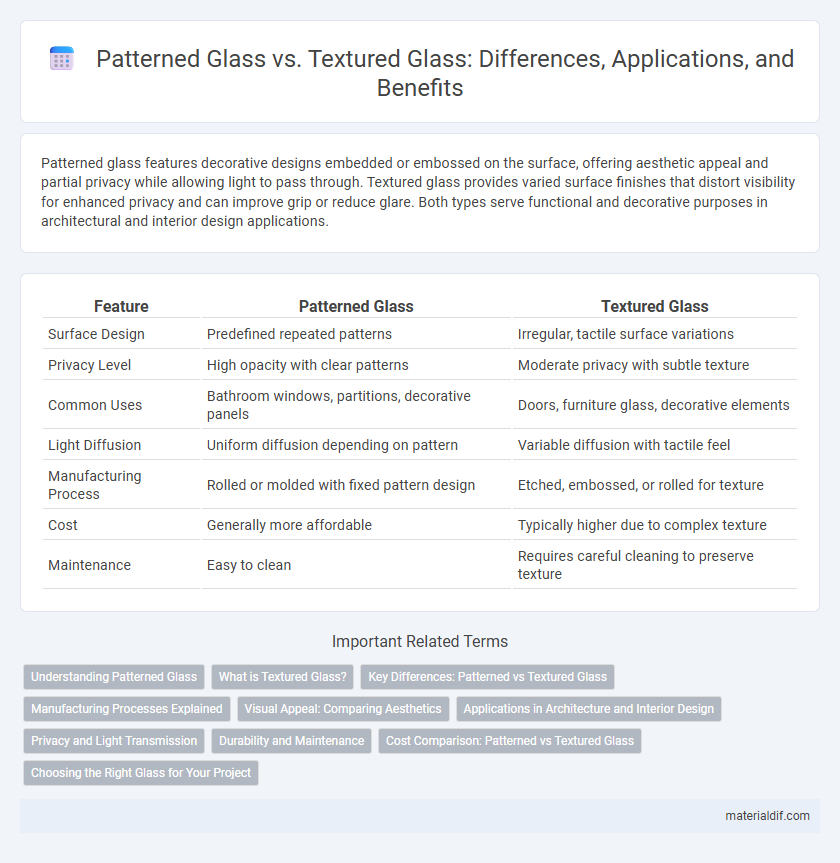Patterned glass features decorative designs embedded or embossed on the surface, offering aesthetic appeal and partial privacy while allowing light to pass through. Textured glass provides varied surface finishes that distort visibility for enhanced privacy and can improve grip or reduce glare. Both types serve functional and decorative purposes in architectural and interior design applications.
Table of Comparison
| Feature | Patterned Glass | Textured Glass |
|---|---|---|
| Surface Design | Predefined repeated patterns | Irregular, tactile surface variations |
| Privacy Level | High opacity with clear patterns | Moderate privacy with subtle texture |
| Common Uses | Bathroom windows, partitions, decorative panels | Doors, furniture glass, decorative elements |
| Light Diffusion | Uniform diffusion depending on pattern | Variable diffusion with tactile feel |
| Manufacturing Process | Rolled or molded with fixed pattern design | Etched, embossed, or rolled for texture |
| Cost | Generally more affordable | Typically higher due to complex texture |
| Maintenance | Easy to clean | Requires careful cleaning to preserve texture |
Understanding Patterned Glass
Patterned glass features distinctive, repeating designs created during the manufacturing process, enhancing privacy while allowing light transmission. It is commonly used in windows, doors, and partitions where decorative appeal and obscured visibility are desired. Patterned glass offers durability and can be customized with various patterns such as reeds, florals, or abstract textures to suit architectural aesthetics.
What is Textured Glass?
Textured glass features raised or embossed designs that create a three-dimensional surface, enhancing privacy and light diffusion while maintaining visibility. Common patterns include rain, linen, or hammered finishes, used in applications like bathroom windows and decorative partitions. This type of glass improves aesthetic appeal and functionality by adding tactile variation compared to flat, patterned glass.
Key Differences: Patterned vs Textured Glass
Patterned glass features repeated designs or motifs created during the manufacturing process, offering decorative elements that enhance privacy while allowing light transmission. Textured glass, on the other hand, involves surface treatments that create irregular or varied tactile finishes, emphasizing grip and diffusion without specific patterns. Key differences include the intentional design repetition in patterned glass versus the random or varied surface effects in textured glass, affecting aesthetics and functional uses in architecture and interior design.
Manufacturing Processes Explained
Patterned glass is produced by rolling molten glass onto engraved steel or cast iron rollers that imprint specific designs onto the surface, creating consistent, repeating patterns during the cooling process. Textured glass manufacturing involves pressing or embossing methods where heat and pressure are applied to shape the glass surface with irregular or varied textures, often achieved through molds or rollers with random or non-uniform patterns. Both manufacturing techniques control light diffusion and privacy levels while allowing customization for architectural and decorative applications.
Visual Appeal: Comparing Aesthetics
Patterned glass features repetitive, uniform designs such as geometric shapes or floral motifs, creating a consistent and elegant visual appeal ideal for decorative and architectural applications. Textured glass offers varied, irregular surface finishes that diffuse light uniquely, enhancing privacy while adding a handcrafted or organic aesthetic element. Choosing between patterned and textured glass depends on desired visual impact--patterned glass emphasizes symmetry and detail, whereas textured glass highlights natural light play and subtle surface variation.
Applications in Architecture and Interior Design
Patterned glass is often used in architectural facades and interior partitions to enhance privacy while maintaining natural light, featuring repetitive geometric or floral designs that add aesthetic appeal. Textured glass, characterized by irregular or raised surface patterns, is favored for shower enclosures, cabinet doors, and decorative panels where tactile and visual depth create focal points. Both types improve light diffusion and style versatility, with patterned glass emphasizing ornamental detail and textured glass enhancing sensory experience in architectural and interior applications.
Privacy and Light Transmission
Patterned glass features repeated designs that obscure visibility while allowing moderate light transmission, making it ideal for enhancing privacy without significantly reducing natural light. Textured glass, characterized by uneven surfaces, distorts images more thoroughly and can vary in opacity, offering higher privacy levels with adjustable light diffusion. Both types balance privacy and light transmission but differ in aesthetic and functional applications depending on the required level of obscuration and illumination.
Durability and Maintenance
Patterned glass features intricate designs embedded during the manufacturing process, providing strong durability resistant to scratches and cracks, making it low-maintenance for both residential and commercial use. Textured glass, created by rolling molten glass through patterned rollers, offers varied surface finishes that can be more vulnerable to wear and may require careful cleaning to avoid trapping dirt in grooves. Both types demand specific maintenance approaches to preserve their appearance, with patterned glass typically outperforming textured glass in long-term resistance to damage and ease of upkeep.
Cost Comparison: Patterned vs Textured Glass
Patterned glass typically costs less than textured glass due to simpler manufacturing processes and lower material complexity. Textured glass involves intricate surface designs or embossing techniques that increase production time and expenses. Choosing patterned glass can offer a more budget-friendly option while still providing privacy and decorative appeal.
Choosing the Right Glass for Your Project
Patterned glass offers distinct, repeated designs embedded within the glass surface, providing privacy while allowing light transmission, ideal for decorative or architectural applications. Textured glass features varied surface irregularities that diffuse light and obscure visibility, enhancing privacy and aesthetic appeal in both residential and commercial settings. Selecting between patterned and textured glass depends on the desired visual effect, level of privacy, and functional requirements of your project, with considerations toward durability and maintenance as well.
Patterned glass vs Textured glass Infographic

 materialdif.com
materialdif.com